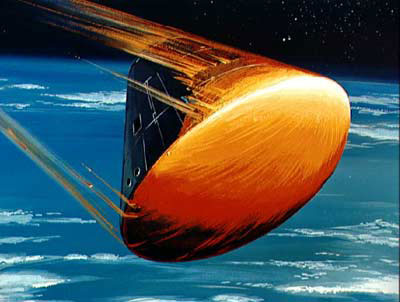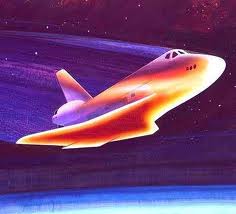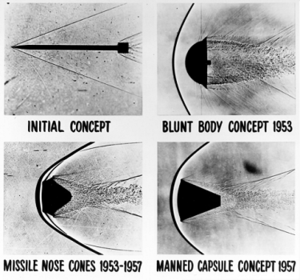Rethinking Ballistic Reentry and Atmospheric Re-entry
Atmospheric re-entry is the most hazardous segment of a spacecraft’s flight. We must find a methodology which provides safety, low-cost, low-weight, ease of maintenance, and allows for quick reuse of the spacecraft. Previous ballistic reentry designs have failed to deliver some or all of these goals.
We must break away from the constraints of earlier atmospheric re-entry systems, which were incredibly expensive and not reusable. As an example, the Apollo spacecraft’s ablative heat shield partially incinerated on reentry, obviously not reusable. Further, one third of the Apollo capsule’s weight was comprised of its heat shield; an impractical design.
The Space Shuttle also had an impractical heat shield that was composed of 24,300 unique ceramic tiles that were individually fitted on the vehicle. This was not a simple or inexpensive solution. These tiles were a maintenance nightmare. The tiles required six or more months of expensive repair and inspections before the Shuttle could be reused. With such a long down time, it is a stretch to call the Shuttle reusable. The unreliability of this ballistic reentry system resulted in the death of a Shuttle crew.



We must understand the nature of ballistic reentry heat generation and shielding. It is a fact that a larger (more blunt) surface area will result in lower atmospheric re-entry surface temperature. As the blunt reentry surface area increases in size, a lower reentry temperature will be the result. In contrast, pointed, aerodynamic, or curved surfaces will result in higher ballistic reentry surface temperatures.
Stated another way, the less aerodynamic and the blunter a reentry vehicle is, the less it will heat up during ballistic reentry. By making the reentry vehicle blunt, air can’t get “out-of-the-way” quickly enough, and acts as an air cushion to push the shock wave and heated shock layer of gas forward (away from the vehicle). Since most of the hot gases are no longer in direct contact with the vehicle, the heat energy would stay in the shock wave gas and simply move around the vehicle to later dissipate into the atmosphere.
Any curvature in the spacecraft’s shape allows relief to the cushion of air, thus allowing the hot gasses to come in closer contact with the spacecraft. It should be noted that the heat shield failure that killed a Space Shuttle crew, occurred on the CURVED leading edge of the Shuttle’s wing.
We must avoid curved surfaces facing into the on rushing air flow. We need to design a spacecraft that provides large blunt surface areas. This will result in lower, safer, ballistic reentry temperatures that will accommodate the use of easily reusable heat shielding materials.
In the book, “What If We Made Space Travel Practical” several solutions to lowering atmospheric re-entry temperatures are presented. Further, newer high-temperature reentry materials are reviewed for their possible application to a ballistic reentry solution.
